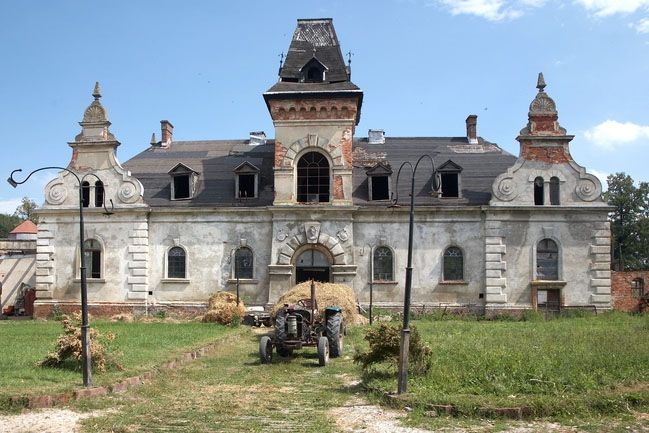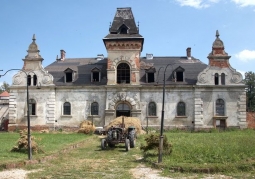Georg von Kramsty Palace - Chwalimierz
No weather data
0.0 /5
Number of ratings: 0
Visiting the picturesque village of Chwalimierz, which is located in Lower Silesia, we easily come across the ruins of a beautiful neo-Gothic palace. It was built in 1884 and was designed by the well-known Wrocław architect Karl Schmidt. To learn the history of this palace, one should look at the silhouette of Georg von Kramst, to which he belonged. Georg von Kramst was a member of an enterprising family that owned many factories and coal mines in Silesia. His family began with a flax weaving mill, which at one time employed 1,300 people. The business prospered very well and was expanded to include more weaving mills and later also mines. The family even bought the whole town of Kudawa Zdrój, which took place in 1851. In 1881 Georg bought the whole village of Chwalimierz. One day he wanted a palace that would be a measure of his wealth. The palace was famous for its unique splendor and sophisticated interiors. The top of the palace tower was decorated with a piece of platinum. In 1942 Georg was arrested by the Gestapo and sent to the Auschwitz-Birkenau concentration camp. He was bought out by his family for a dizzying 3.5 million marks. A few months later he died of complications caused by exhaustion by staying in the camp. Unfortunately, after the Red Army entered Poland in 1945, its rich equipment was stolen by them, and the remains were later collected by nearby residents. There are only ruins left that are hard to find nowadays. They are hidden deep in the forest, but this should not be a major problem for people who like to explore and visit this type of place.
Komentarze
No results
Nearby places
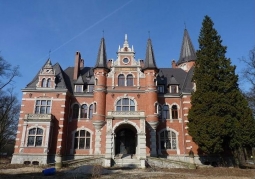
Karol Scheibler's Palace - Kwietno
Category: PalacesThe palace was built in the neo-Renaissance style, built by the widow of Karl Scheibler in 1891-1892. The building has a very varied facade, with a lot of turrets, bay window projections, gables and arcades. Brick...
10 km
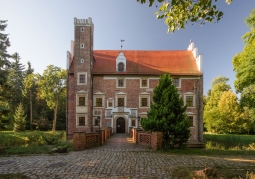
Water Castle - Wojnowice
Category: LocksA Gothic-Renaissance surface castle located about 25 km from the center of Wrocław, is located at the lowest point of the area, among wetlands and forests. It is one of the few castles of this type in Poland. Once,...
16 km
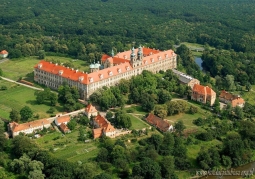
Cistercian Abbey - Lubiąż
Category: MonasteriesCistercian Abbey in Lubiąż - a Cistercian monastery complex in Lubiąż, one of the largest monuments of this class in Europe, which is also the largest Cistercian abbey in the world. This abbey is called a...
17 km

Blücher Palace - Krobielowice
Category: PalacesThe Lower Silesian palace of the Wrocław poviat, the Kąty Wrocławskie commune from the 16th-19th centuries. Built on the site of a former defensive structure in the second half of the 16th century as a Renaissance...
21 km
Nearby places

Karol Scheibler's Palace - Kwietno
Category: PalacesThe palace was built in the neo-Renaissance style, built by the widow of Karl Scheibler in 1891-1892. The building has a very varied facade, with a lot of turrets, bay window projections, gables and arcades. Brick...
10 km

Water Castle - Wojnowice
Category: LocksA Gothic-Renaissance surface castle located about 25 km from the center of Wrocław, is located at the lowest point of the area, among wetlands and forests. It is one of the few castles of this type in Poland. Once,...
16 km

Cistercian Abbey - Lubiąż
Category: MonasteriesCistercian Abbey in Lubiąż - a Cistercian monastery complex in Lubiąż, one of the largest monuments of this class in Europe, which is also the largest Cistercian abbey in the world. This abbey is called a...
17 km

Blücher Palace - Krobielowice
Category: PalacesThe Lower Silesian palace of the Wrocław poviat, the Kąty Wrocławskie commune from the 16th-19th centuries. Built on the site of a former defensive structure in the second half of the 16th century as a Renaissance...
21 km
